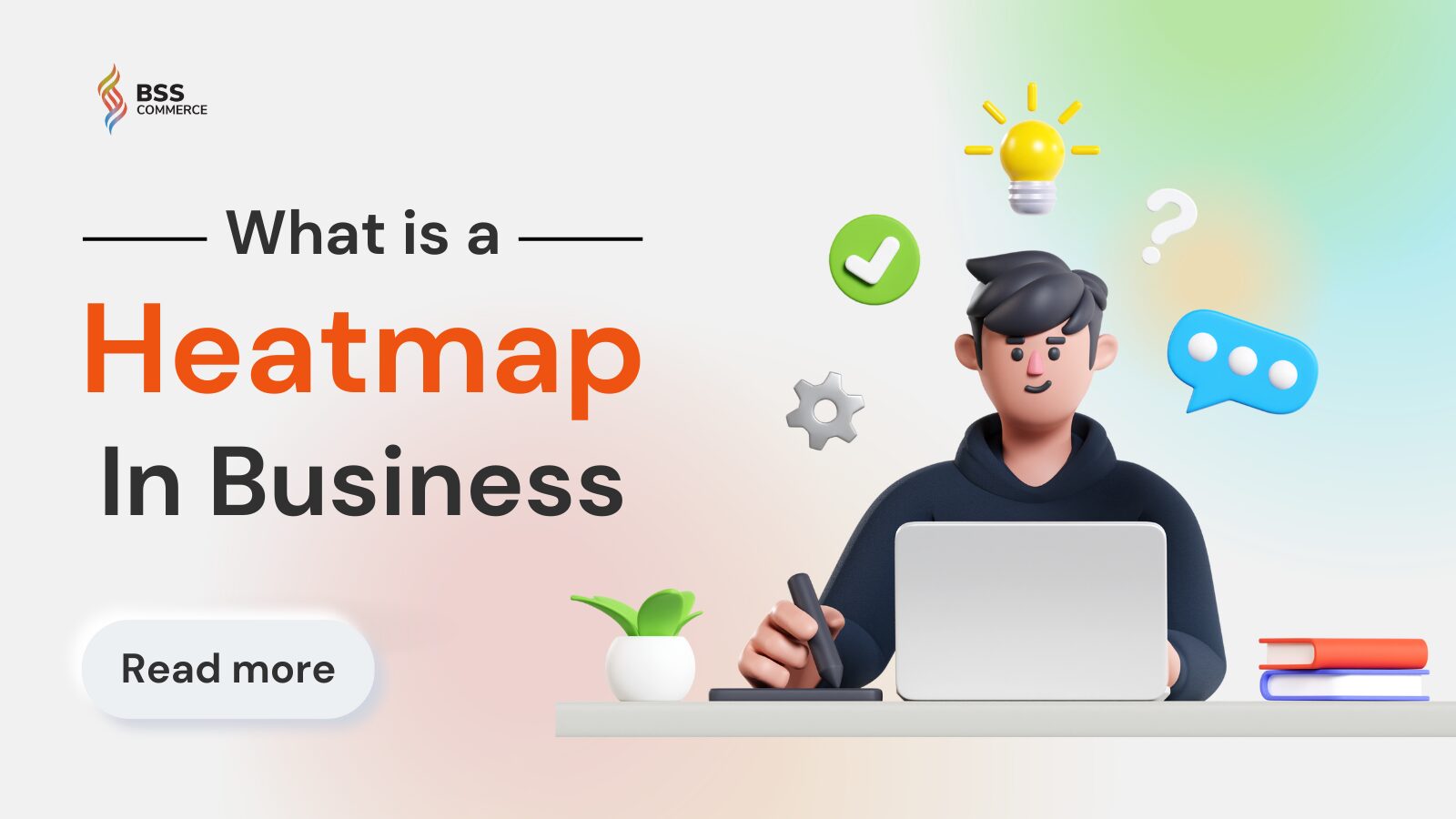Are you looking to understand the way users browse and interact with your business website? If so, then heatmaps are the effective means by which you can analyze the interactions of your audience on the website, helping you build a more fascinating experience for them. In this article, we will answer the question “what is a heat map in business”, talk about how a heat map works, how heatmaps are beneficial for businesses, and provide you with a strong heat map tool that will help improve your business website.
Contents
What Is a Heat Map in Business?
Heat maps are one of the crucial data visualization tools that businesses use to understand how users will interact with their websites. A heat map can measure everything, from how far down a user scrolls on a web page to where they click, so business owners can better understand what aspects of their websites are performing well and which ones need improvement.
Heat maps are graphical representations that show information using a color scale rather than numbers, which may be confusing to anyone. In heat maps, a color scale will make them more user-friendly and understandable because different colors show different values. Generally speaking:
- Warmer colors – reds, oranges, and yellows – indicate “more used” or “more popular” sections of your map;
- Cooler colors – greens, blues, and purples – represent less frequently used sections of your map.

What Is a Heat Map Used for in Business?
If you know the definition of a heat map, you might be able to guess the answer for the question “what is the purpose of a heat map?”. There are many different uses for heat maps when it comes to business. They are great at helping to find out where the data exists and where it does not, which provides companies with very valuable insights.
Firstly, heat maps help measure a business’s performance in a certain area. This might include a number of various metrics such as the following:
- Sales;
- Customers;
- Revenue;
- Deliveries;
- Service calls.
Using sales as an example, heat maps outline to companies where their products are most in demand. This innately provides feedback on which areas you might want to target with online advertising. If you know conversion rates are high in a certain area, you are more likely to drive sales there.
On the other hand, if one region is not pulling in sales, that could indicate your products are not desired in that market. However, it could be an opportunity in disguise. Maybe you are not seeing any sales because you have neglected that region. By increasing your advertising in that area, you might actually get some new customers.

Secondly, heat maps are used for planning and strategy. By plotting your sales reps and locations, you get an idea of where your coverage is strong and where it is lacking. This gives an opportunity to fill in the gaps with new locations so that your customers may be served better.
Lastly, heat maps are an essential tool for research. They are ideal for the measurement of a wide range of demographic data, including:
- Population;
- Income;
- Housing;
- Gender;
- Race;
- Age.
That is the necessary information about pinpointing the location of your ideal customers to devise strategies to run a marketing campaign and choose new locations to establish your business.
How Does a Heat Map Work?
How a heat map works depends on the type. There exist several kinds, but they generally could be bucketed into two categories: interaction and attention heatmaps.
Interaction heat maps measure various engagements and employ tracking codes to capture the interaction of a user with a website that includes clicks, scrolls, mouse movements, and many other factors.
Attention heat maps are a little more complicated and track ways in which users view content on your website by monitoring or even predicting their eye movements.
YOU MAY CONCERN: How to Use Heatmap: A Comprehensive Guide
Benefits of Using a Heat Map
Heat maps are one of the strongest data visualization tools yet, and they offer an enormous set of benefits as a resource to many industries and applications. The advantages of heat mapping include – but are not limited to – the following:
Real-Time Data Insight
- Visual simplicity: Heat maps can be used to present data through color gradients, thus enabling the observation of meaningful information at a single glance. In this case, visual ease about temperature enables users to quickly understand patterns, trends, and anomalies without having to sift through an extensive table or report.
- Deep understandability: Heat maps depict data in visually intuitive manners, thus supporting the discovery of trends as well as relationships, which might otherwise go unnoticed if the data were presented otherwise.
Improved Decision-Making
- Key area focus: Heat maps guide one through a dataset by highlighting the areas where the intensities are high or low. This focus allows the decision-maker to put more emphasis on acting in those areas based on data-driven insight and hence come up with effective strategies.
- Data-driven strategies: Heat maps enable immediately quick identification of emerging trends and deviations, so they are able to support informed decision-making. Whether concerning marketing, operational, or risk management decisions, decisions would likely be better if they remain based on comprehensive data analysis with HeatMaps.

Universality Across Industries
- Broad application: The heat maps prove versatile in application across different fields of marketing, finance, healthcare, logistics. They can provide tracking of customer behavior on a website, financial performance monitoring, analysis of patients, or supply chain optimization.
- Customizable for different needs: With different data and objectives, heat maps can be customized to bring out different aspects of the dataset – be it geographic distribution, time-based trends, or performance metrics.
Enhanced User Engagement
- Interaction: Generally speaking, Heatmaps, when presented in the digital environment, are interactive in nature, enabling users to hover over or click on specific areas for more detailed data, thus making data exploration more dynamic and informative.
- Reporting: Heat maps work very well in reports and presentations, where they can help deliver complex data in very short periods of time to stakeholders. Their very vivid nature, coupled with clarity, ensure they keep audiences interested and that the key messages are well driven across.
Efficiency in the Analysis of Huge Data
- Handling large datasets: They are especially useful when handling huge sets of data, in which case the conventional methods of analysis would be annoying. They can summarize huge amounts of information into one comprehensible visualization – a result expected with much ease of time and reduced cognitive loading by users.
- Real-time data monitoring: Heat maps are very important in real-time data environments, such as network monitoring or financial trading. They can paint instantaneous pictures of the status of key metrics and allow quick responses to emerging issues.

Businesses and Industries That Benefit From Heat Maps
By now, you might be wondering whether the heat maps apply to your business and whether you could benefit from this tool. The truth is, heat maps can work for virtually any organization that collects and uses data to improve its operations, financials, sales, and customer service or marketing effectiveness. Here are a few ways different industries might derive value from this tool:
- Sales: Businesses of sale would be able to use a heat map to measure sales performance in a given area, find deficiencies in sales coverage, and measure demographic data for market research.
- Franchises: Customer heat maps would highlight to them places in which new franchises could be opened.
- Healthcare: During the most recent pandemic, medical professionals have made common use of heat maps in identifying specific areas where outbreaks of COVID had taken place.
- Finance: Using a heat map, investment professionals can track down where high net-worth individuals exist. One could then begin some targeting of those areas through advertising.
- Service businesses: Utilizing the power of heat maps helps these companies identify areas where service calls take place more recurrently. With that, businesses can scale up efforts in areas that demand their services the most or find areas that might be under-serviced.
- Food delivery businesses: Using the heat maps that show where their customers are, they place their distribution centers accordingly.
- Real estate: They are helpful in analyzing the neighborhood demographics. This goes a long way in selling homes to interested buyers.
- Governments: Heat maps of the population, age, income, housing, education, etc., help the government decisions on social programs and infrastructure.
Regardless of what industry you come from, heat maps can probably be useful in one way or another.
DISCOVER: Top 5 Shopify Session Recording Apps: An In-Depth Review
Heat Map Business Success Stories
There are several examples available as to how companies have plotted their data using heat maps and thereby were able to optimize their operations or marketing effort. Following are some business examples showing how companies have used heat maps to analyze data, understand the customer, and grow their businesses.
Trulia

Real estate listing sites like Trulia do this to help their website visitors get familiar with the location they are thinking of moving into. How a company uses a heat map as an added value to customers is when Trulia and other similar sites plot information on maps, such as average home values in certain neighborhoods, school rankings, and crime rates.
Foursquare

Foursquare is a location-based social network that enables its users to check-in at locations around the world. Using a heat map tool, Foursquare can visually represent the number of check-ins in major cities. It gives city planners an idea of density in terms of movement in the downtown cores. This helps cities and transit companies become more efficient in setting up transportation services.
Staples

Large international retailers like Staples can benefit in many ways from heat maps. One of the ways is by comparing one’s location against the location of their competitors. This gives the strategic planners an opportunity to know where chances to compete or avoid the risks of market saturation are. Heat maps will further let a retailer understand the demographics of their most successful locations so that they can duplicate their successes in similar, untapped regions.
READ MORE: Top 13+ Best Apps on Shopify For Unlocking Success
Business Mapping With MIDA: Heatmap, Record & Replay
MIDA: Heatmap, Record & Replay by BSS Commerce is an innovative eCommerce analytics tool. It provides deep insights into Shopify’s customer behaviors that no shop owner has ever had before. Being rated 4.9, this application will let you understand your customer journey and improve the shopping experience of your customers.
Full session recording and heatmaps by MIDA let you watch what your customers do on your site. Gain insight into the experience of customers on your online store and cut assumptions to give validation for designs on your site. Sessions are grouped into abandoned carts, abandoned checkout, and successful orders to help you find room for improvement.
✨✨✨ TRY NOW: MIDA: HEATMAP RECORD & REPLAY
Key Feature of MIDA
- Heatmaps: Visualizations of where customers are clicking, therefore providing some sense of what they find interesting and what not.
- Session Recording: The ability to replay customer visits gives a clear view of the shopper’s journey through the online store.
- Analytics: Track and report critical data about customer interactions, including checkout and add-to-cart sessions, among others.
- Filter recordings by events: Segmentation of recordings according to key events such as abandoned carts, checkout procedures, or successful transactions.
- Optimized for speed: Record sessions without affecting performance in your store.
Unique Selling Points of MIDA
- MIDA has full-featured features to trace customers: watch recordings, provide heatmaps and collect feedback from customers through surveys.
- MIDA uses advanced technologies in creating heatmaps. Different types of heat maps are available like view heatmap, click heatmap, move heatmap, scroll heatmap, share heatmap, and area heatmap. Specifically, area maps are exclusively available with MIDA.
- In MIDA, the recorded-playback user interface is designed to be user-friendly. In that matter, monitoring customer behavior with ease can be even more convenient.
Customer Feedback
Merchants highly value this app for its session recordings; heatmaps that allow them to easily track customers’ purchasing processes, including where they click and hover; and detailed analytics that help analyze customer behavior and improve website functionality.

They also like how they can categorize sessions, for example, abandoned carts and orders completed, which makes navigation and analysis so much easier. It helps customers understand what users are searching for and what they want from the store.

Also noted is GDPR compliance of the app, and multi-store support. Users often praise it for being easy to work with, having a very straightforward setup, and responsive customer support. Its updates and continuous evolution to listen to its customers are also mentioned.

Bottom Up
Everyone and each business can benefit from heat maps. They will show you how to visualize data into a more meaningful understanding of how your target audience interacts with your website, thereby optimizing your website to increase conversion rates and improve user engagement. In this article, we have shown “what is a heat map in business”, “what is a heat map used for”, “what is the purpose of a heat map”, how a heat map can benefit your business, and suggest MIDA as a powerful tool that you can use for your business website. If you find this blog helpful, check out BSS Commerce for more eCommerce blogs!
CONTACT NOW to let us know your problems. We are here to lend a hand whenever you need it.




